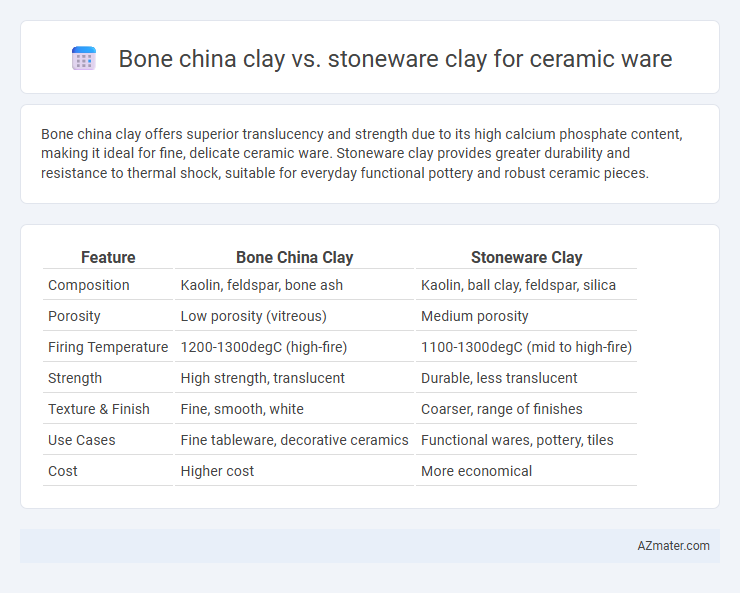Bone china clay offers superior translucency and strength due to its high calcium phosphate content, making it ideal for fine, delicate ceramic ware. Stoneware clay provides greater durability and resistance to thermal shock, suitable for everyday functional pottery and robust ceramic pieces.
Table of Comparison
| Feature | Bone China Clay | Stoneware Clay |
|---|---|---|
| Composition | Kaolin, feldspar, bone ash | Kaolin, ball clay, feldspar, silica |
| Porosity | Low porosity (vitreous) | Medium porosity |
| Firing Temperature | 1200-1300degC (high-fire) | 1100-1300degC (mid to high-fire) |
| Strength | High strength, translucent | Durable, less translucent |
| Texture & Finish | Fine, smooth, white | Coarser, range of finishes |
| Use Cases | Fine tableware, decorative ceramics | Functional wares, pottery, tiles |
| Cost | Higher cost | More economical |
Introduction to Ceramic Clays: Bone China vs Stoneware
Bone china clay is a refined ceramic material composed primarily of kaolin, feldspar, and bone ash, known for its whiteness, translucency, and high strength, making it ideal for fine, delicate ceramic ware like tableware and decorative items. Stoneware clay contains a higher proportion of non-refractory materials such as quartz and feldspar, resulting in a dense, durable body fired at higher temperatures, suitable for utilitarian pottery like dishes, mugs, and cookware. The choice between bone china and stoneware clays hinges on desired properties such as translucency, strength, firing temperature, and end-use functionality in ceramic ware.
Composition and Raw Materials
Bone china clay is composed primarily of kaolin, feldspar, and about 25-30% bone ash derived from calcined animal bones, which imparts translucency and strength. Stoneware clay consists mainly of kaolin, ball clay, feldspar, and quartz, with minimal to no bone ash, resulting in a denser, more durable, and less translucent ceramic body. The inclusion of bone ash in bone china significantly lowers firing temperature and enhances whiteness, while stoneware clay requires higher firing temperatures for vitrification and strength.
Physical Properties Comparison
Bone china clay exhibits higher translucency, greater whiteness, and a finer particle size compared to stoneware clay, resulting in a lighter, more delicate feel. Stoneware clay is denser and more durable, with higher firing temperatures typically between 1200degC to 1300degC, which leads to increased strength and chip resistance. In contrast, bone china fires at lower temperatures around 1200degC but achieves superior vitrification, making it more translucent yet less robust against heavy impacts.
Firing Temperatures and Processes
Bone china clay typically fires at higher temperatures ranging from 1200degC to 1300degC, resulting in a translucent and delicate ceramic ware with a smooth, white finish. Stoneware clay fires at lower temperatures between 1100degC and 1200degC, producing durable, opaque pottery with a denser and more stone-like texture. The firing process for bone china involves a slower, controlled ramp-up to maintain its fine structure, while stoneware clay tolerates a more gradual cooling phase to enhance strength and resistance.
Color and Aesthetic Differences
Bone china clay produces ceramic ware with a translucent, white, and delicate appearance, enhancing intricate designs and fine details due to its high kaolin and bone ash content. Stoneware clay results in a denser, more opaque finish with a natural, earthy tone ranging from light gray to brown, offering a rustic and robust aesthetic. The color variation in stoneware allows for textured glazes and matte finishes, while bone china's smooth surface favors vibrant, glossy glazes and refined elegance.
Strength and Durability
Bone china clay exhibits superior strength and durability compared to stoneware clay due to its high feldspathic and bone ash content, which promotes a more vitrified, translucent, and chip-resistant ceramic body. Stoneware clay, while durable and less porous after firing, generally has a coarser texture and is more prone to micro-cracking under heavy stress or thermal shock. The enhanced mechanical properties of bone china make it ideal for fine, delicate ware requiring long-lasting resilience, whereas stoneware suits utilitarian purposes demanding toughness over aesthetic translucency.
Porosity and Water Absorption
Bone china clay exhibits significantly lower porosity and water absorption rates compared to stoneware clay, resulting in a denser, more vitreous ceramic body ideal for fine tableware. Stoneware clay typically has higher porosity, which can range from 1% to 5%, leading to greater water absorption and making it more porous and less translucent than bone china. These differences in porosity and water absorption directly impact the durability, strength, and aesthetic qualities of the finished ceramic ware.
Applications in Ceramic Ware
Bone china clay is ideal for producing delicate, translucent ceramic ware such as fine tableware and decorative pieces due to its high whiteness and strength. Stoneware clay suits functional ceramics including mugs, bowls, and dinnerware, offering durability and resistance to chipping and thermal shock. Both materials excel in different applications, with bone china favored for elegance and stoneware for everyday utility.
Cost and Availability
Bone china clay typically costs more than stoneware clay due to its refined composition, including bone ash, which enhances translucency and strength. Stoneware clay is more widely available and generally more affordable, making it a popular choice for mass production and everyday ceramic ware. Manufacturers often select bone china clay for high-end, delicate items, while stoneware clay is preferred for durable, functional pieces with lower material costs.
Environmental Impact and Sustainability
Bone china clay typically involves the use of animal bone ash, which raises ethical concerns but offers a higher recycling potential due to its fine particle size and low firing temperature, resulting in lower energy consumption. Stoneware clay, derived from natural mineral deposits, requires higher firing temperatures up to 1300degC, leading to greater energy use and carbon emissions, but it often contains fewer additives and chemicals, making it more biodegradable and environmentally benign. Sustainable ceramic ware production prioritizes locally sourced stoneware clay to reduce transportation emissions, while innovation in bone china formulations aims to replace animal-derived components with plant-based alternatives to enhance eco-friendliness.

Infographic: Bone china clay vs Stoneware clay for Ceramic ware
 azmater.com
azmater.com